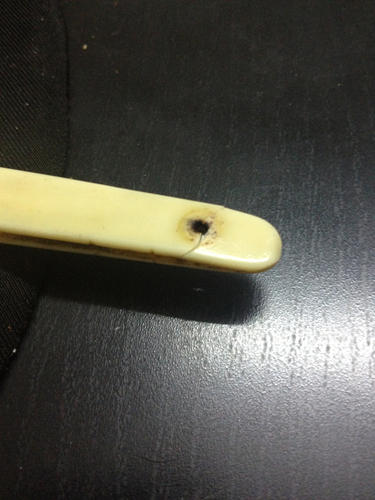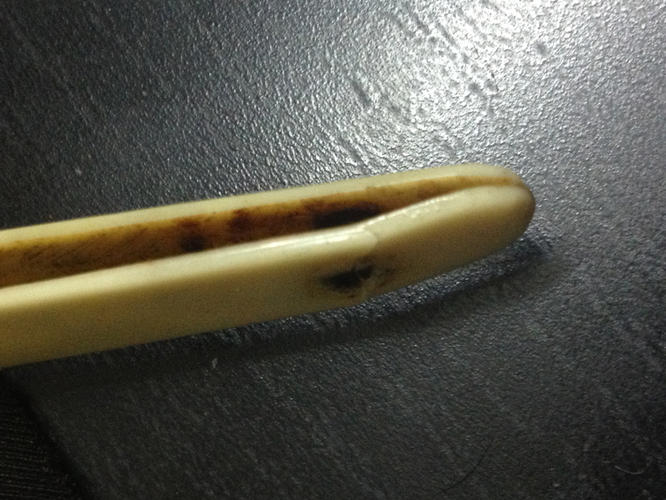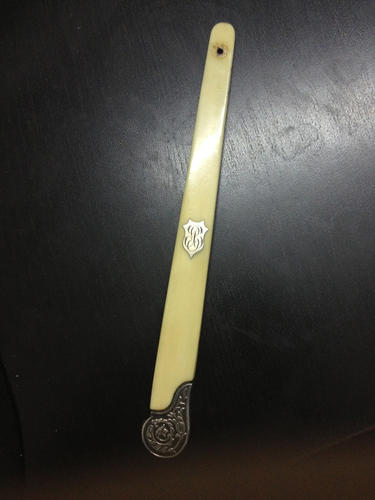Results 1 to 10 of 14
Hybrid View
-
07-14-2013, 10:40 PM #1
 Oh no...I just cracked my french Ivory scales now
Oh no...I just cracked my french Ivory scales now
while trying to unpin it from its rusty rod and washers.
Is there anything I can do? I really like these scales and I was so stupid thinking I could just unpin the, like I do with other scales...It didn't fall off and it seems like the piece is still attached to the scales, kind of like a half broken branch.
Is there some comforting news for me on how to fix it or should I start to weep now?



Last edited by OrSh; 07-14-2013 at 10:42 PM.
-
07-15-2013, 12:07 AM #2

Ouch!
You may clean them thoroughly and then use a bit of acetone to clean the break. Make a big FLAT thrust washers out of a tin can, not aluminum, or of shim brass to fit inside the scales. Those are added to both scales in place of normal sized thrust washers...those really thin ones. Yours seem to allow almost a 5/16ths diameter of washer. you could also make them diamond shaped, longer than tall.
I have used this method on some fancy bone scales.
Align the pin hole and the thrust washer carefully
Use a clamping method that won't stick to the scale, assure that the edges of the crack align exactly.
Then use the thinnest CA you can buy and wick a little bit from off the drop at the end of a CA dipped pin into the crack.
It may take a couple of additions of the CA after each one solidifies
Then use fine 2k grit wet dry paper a to remove the excess CA almost to the surface. ( Cleanest paper over the years has been Meguiars)
Use a single edge razor blade to carefully scrape the surfaces level.
Then carefully buff with a Micro-mesh abrasive sheet.
Re-drill the holes with a 1/16th inch bit and countersink the outside a bit to prevent splitting when the pin swells while peening it.
Good luck those are beautiful scales!
~Richard
-
The Following User Says Thank You to Geezer For This Useful Post:
HARRYWALLY (07-15-2013)
-
07-15-2013, 12:21 AM #3

Thank you for the detailed answer Geezer! Perhaps you have a picture of your work? I need to see it as a clear image to fully understand :-)
-
07-15-2013, 12:35 AM #4

No I do not. I will put the answer nicely. Do a search for scale repair / repairing ivory here. There are a lot of posts.
I have enough of a problem getting any work done without setting up and making photos of everything I do. And, 'sides that I am really lazy.
Think about it step by step. Figure out how to use the materials you have and the photo series that a search will bring to light..
I'm off.
~Richard
-
07-15-2013, 12:37 AM #5Senior Member


- Join Date
- Jan 2011
- Location
- Roseville,Kali
- Posts
- 10,432
Thanked: 2027
that really sucks,geezer knows what he is doing,just a note tho,be carefull with acetone if the scales are celluloid.
-
The Following User Says Thank You to pixelfixed For This Useful Post:
Geezer (07-15-2013)
-
07-15-2013, 12:56 AM #6

French Ivory is celluloid. Do the scales smell of camphor if sanded lightly? That would confirm.
It can be fused using a mix containing acetone but I don't know the process or formula.
pm Neil Miller. He may be able to help.The white gleam of swords, not the black ink of books, clears doubts and uncertainties and bleak outlooks.
-
The Following User Says Thank You to onimaru55 For This Useful Post:
cudarunner (07-15-2013)
-
07-15-2013, 07:07 AM #7

Since English is not my native language it's a bit hard for me to fully understand the whole process, that's why a photos will do the work in my case.
And about the scales material, it is made out of real ivory and these are french style scales from france :-) this is no celluloid by any mean. Sorry for any missunderstanding that caused by my broken english.
-
07-18-2013, 02:02 AM #8

That razor is outstanding! I would love to find a similar one some day. Nice save by the way!


 22Likes
22Likes LinkBack URL
LinkBack URL About LinkBacks
About LinkBacks






 Reply With Quote
Reply With Quote



